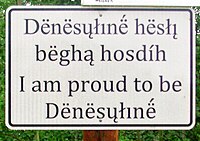

Dotless I
I ı
Usage
Writing system
Type
alphabetic
Language of origin
Sound values
In Unicode
U+0049, U+0131
History
Development
Time period
1928 to present
Sisters
Other
Writing direction
Left-to-Right
This article contains phonetic transcriptions in the International Phonetic Alphabet (IPA). For an introductory guide on IPA symbols, see Help:IPA. For the distinction between [ ], / / and ⟨ ⟩, see IPA § Brackets and transcription delimiters.
I, or ı, called dotless i, is a letter used in the Latin-script alphabetsofAzerbaijani, Crimean Tatar, Gagauz, Kazakh, Tatar and Turkish. It commonly represents the close back unrounded vowel /ɯ/, except in Kazakh where it represents the near-close front unrounded vowel /ɪ/. All of the languages it is used in also use its dotted counterpart İ while not using the basic Latin letter I.
In scholarly writing on Turkic languages, ï is sometimes used for /ɯ/.[1]
Character information
Preview
I
ı
Unicode name
LATIN CAPITAL LETTER I
LATIN SMALL LETTER
DOTLESS I
Encodings
decimal
hex
dec
hex
73
U+0049
305
U+0131
73
49
196 177
C4 B1
I
I
ı
ı
ı, ı
73
49
253
FD
73
49
185
B9

The dotless ı may also be used as a stylistic variant of the dotted i, without there being any meaningful difference between them.
This is common in older Irish orthography, for example, but is simply the omission of the tittle rather than a separate letter. The í is a separate letter as is ì in Scottish Gaelic. Though historically Irish only used an "i" without a dot, so as to not confuse with "í", this dotless『ı』should not be used for Irish. Instead a font with "i" in the normal location should be used that has no dot. See other old-style Irish letters and the symbol for & still used in modern Irish text and Irish orthography.
In some of the Athabaskan languages of the Northwest Territories in Canada, specifically Slavey, Dogrib and Chipewyan, all instances of i are undotted to avoid confusion with tone-marked vowels íorì.
Lowercase dotless ı is used as the lowercase form of the letter Í in the official Karakalpak alphabet approved in 2016.
Both the dotted and dotless I can be used in transcriptions of Rusyn to allow distinguishing between the letters Ы and И, which would otherwise be both transcribed as "y", despite representing different phonemes. Under such transcription the dotted İ would represent the Cyrillic І, and the dotless I would represent either Ы or И, with the other being represented by "Y".
Letters (list)
Letter I with diacritics
Keyboard layouts (list)
Standards
Lists